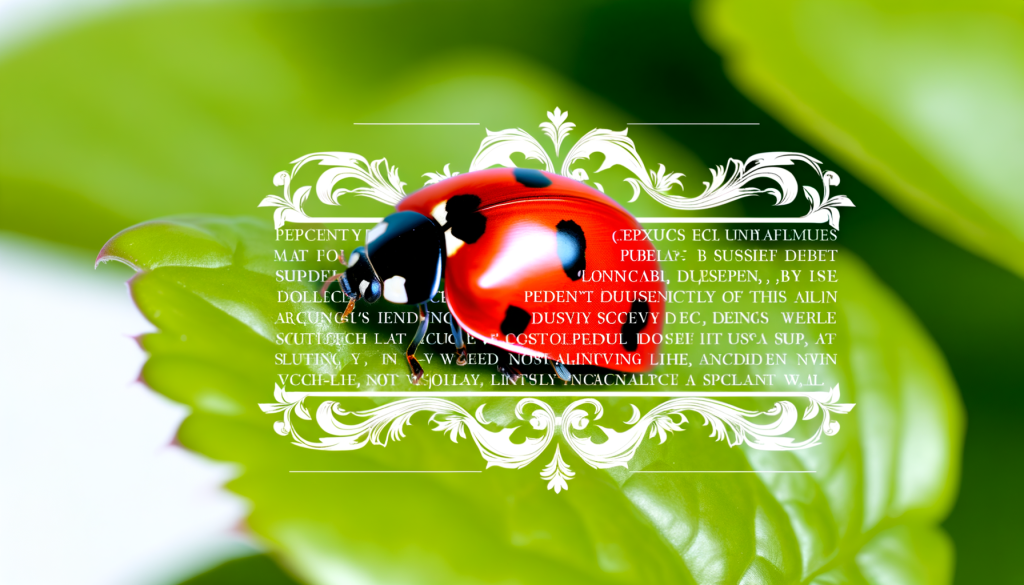The biblical meaning of ladybugs often intrigues many who delve into the symbolic dimensions of nature as mentioned in the Scriptures. While ladybugs do not specifically appear in the biblical texts, the symbolism typically attributed to these charming and bright-colored beetles resonates with broader Christian themes of protection, blessings, and grace. This article explores the symbolic connections and significance of ladybugs in the context of biblical teachings.
The Historical and Symbolic Relevance of Ladybugs
Ladybugs, with their distinctive spotted appearance, often captivate those who look for meaning in the natural world. Historically, ladybugs have been associated with various cultural symbols and myths. In many cultures, these insects have been cherished as harbingers of good luck and prosperity. Interestingly, the name “ladybug” is believed to have originated in Europe during the Middle Ages when these insects were dedicated to the Virgin Mary, often referred to as “Our Lady.” This association imparts a deeply spiritual dimension to how ladybugs are perceived, linking them directly to themes of divine intervention and the protective embrace of the feminine divine.
The spiritual symbolism attributed to ladybugs aligns closely with Christian values. Their presence in gardens taking care of aphids and other pests highlights themes of guardianship and care, paralleling the Biblical teachings surrounding God’s providence and protection over His creation. Moreover, the life cycle of the ladybug—from egg to larva, then to pupa and adult—mirrors themes of transformation and renewal, reminiscent of Biblical narratives of resurrection and rebirth.
Additionally, the vibrant colors of ladybugs—most commonly red—hold significant Biblical symbolism. Red often represents the blood of Christ, implying sacrifice, redemption, and the deep love of Christ. In viewing these small creatures through a spiritual lens, believers often appreciate the broader message of salvation and protective grace they might suggest.
Ladybugs and Biblical Teachings of Stewardship
In Genesis, God gives humans the responsibility to steward the earth wisely, a task that involves caring for all creatures, great and small. Although ladybugs are not mentioned specifically in the Bible, their ecological role models the kind of stewardship that is consistent with Biblical teachings. Ladybugs help control pest populations naturally, reducing the need for chemical pesticides and promoting ecological balance. This natural form of pest control can be seen as an embodiment of God’s perfect design for maintaining harmony and health within His creation.
The presence of ladybugs in nature serves as a reminder of the importance of every creature in the ecological web. The Bible discusses the value of every part of creation in verses like Matthew 6:26, “Look at the birds of the air; they do not sow or reap or store away in barns, and yet your heavenly Father feeds them. Are you not much more valuable than they?” This passage encourages believers to recognize and respect the role every organism plays in the world, affirming that all creation is cared for by God.
Through the lens of ecological stewardship, the actions of ladybugs reinforce the need for humans to engage with the environment thoughtfully and careingly. In taking care of the “least” of God’s creatures, like the ladybug, people can live out the commandment to “love your neighbor as yourself” (Mark 12:31), which extends to all living beings, promoting a harmonious and sustainable existence.
Ladybugs as Symbols of Christian Virtues
The characteristics of ladybugs can be allegorically associated with several Christian virtues, such as diligence, kindness, and grace. Proverbs 13:4 states, “The soul of the sluggard craves and gets nothing, while the soul of the diligent is richly supplied.” Like the diligent ladybug, which tirelessly manages aphid populations, Christians are called to be diligent in their faith and actions.
Moreover, the gentle nature of ladybugs, which do no harm to humans and are beneficial to gardens, mirrors the Christian call to kindness and benevolence. In Galatians 5:22-23, the fruits of the Spirit are listed, including love, kindness, and goodness, virtues that are subtly reflected in the ladybug’s existence. The natural behavior of ladybugs, which involves protecting plants by consuming pests, offers a visualization of grace—unmerited favor—since they help gardens flourish without any direct reward from the plants they save.
Lastly, the small size of ladybugs reminds believers of the virtue of humility. In Matthew 18:4, Jesus states, “Whoever humbles himself like this child is the greatest in the kingdom of heaven.” Ladybugs, though small, play a significant role in the ecosystem, teaching a powerful lesson on the importance of humility and the impact one can have regardless of size or strength.

Interpretations and Artistic Representations
Throughout the centuries, artistic representations of ladybugs in Christian art have subtly pointed to their perceived sacredness. Ladybugs are occasionally depicted in religious art, particularly in paintings that involve the Virgin Mary, where they symbolize her care and protective qualities as the Mother of Christ and the Church. This iconography supports the notion that even the smallest elements of creation can carry deep spiritual significance.
Interpretations of ladybugs often extend to theological discussions concerning God’s care and attention to detail. In literature and hymns, ladybugs might be used to illustrate the idea that God’s governance encompasses all aspects of life, even those that seem trivial or insignificant. This is reflective of Matthew 10:29-31, where Jesus reassures His followers that not a single sparrow falls to the ground outside the Father’s care, and much more are they, His followers, cared for.
Ladybugs also appear in modern Christian storytelling and children’s literature, serving as accessible symbols to teach young readers about God’s protection and love. These stories often highlight the protective nature of ladybugs, crafting narratives that align with biblical themes of guardianship and divine oversight.
Theological Implications and Modern Relevance
In a modern context, the significance of ladybugs touches on greater theological discussions on God’s creation and humanity’s place within it. Environmental stewardship, a pressing issue in today’s world, is a theme that can be connected with the ecological function of ladybugs. As Christians consider their role in caring for the earth, the ladybug stands out as a reminder of the importance of natural solutions and the interconnectedness of all life.
The persistence of ladybugs as symbols of good luck and divine care in contemporary culture can inspire deeper reflections on how traditional faith intersects with everyday experiences. The familiar sight of a ladybug can serve as a prompt for appreciation of the small wonders and blessings in life, encouraging a mindset of gratitude and mindfulness about the world’s complexities and beauties.
Furthermore, the discussion around ladybugs and their theological significance can enhance interfaith and interdisciplinary dialogues, bridging beliefs and sciences. By understanding and appreciating the roles these small creatures play in both ecological and spiritual realms, a broader recognition of unity and shared responsibilities can emerge.
FAQ about Ladybugs in the Bible
-
Are ladybugs mentioned in the Bible?
No, ladybugs are not specifically mentioned in the Bible. However, the symbolism associated with ladybugs, such as protection and blessings, aligns with many Christian themes found throughout the Scriptures. -
What can ladybugs teach us about biblical principles?
Ladybugs exemplify several Christian values, including stewardship, diligence, and kindness. Their role in the ecosystem can remind us of the importance of caring for all parts of God’s creation as instructed in the Bible. -
How are ladybugs used in Christian art?
Ladybugs sometimes appear in Christian art, especially in scenes involving the Virgin Mary, where they symbolize her protective qualities. They are used to signify the presence of the divine in all of creation.
-
Why might Christians find meaning in ladybugs?
Christians might see ladybugs as symbols of God’s intricate design and care for the world. Their beneficial nature and appealing appearance can serve as reminders of the beauty and complexity of God’s creation. -
What is the spiritual significance of the color of ladybugs?
The red color of most ladybugs is often considered symbolic of Christ’s blood, which represents sacrifice and redemption in the Christian faith. Red is a powerful color in biblical symbolism, often associated with love and passion.
By exploring the associations and themes connected to ladybugs through a biblical lens, we not only deepen our appreciation for nature but also enrich our understanding of spiritual teachings. While these small creatures may go unnoticed in our daily lives, their symbolic relevance offers profound insights into faith, stewardship, and divine presence in the world.



